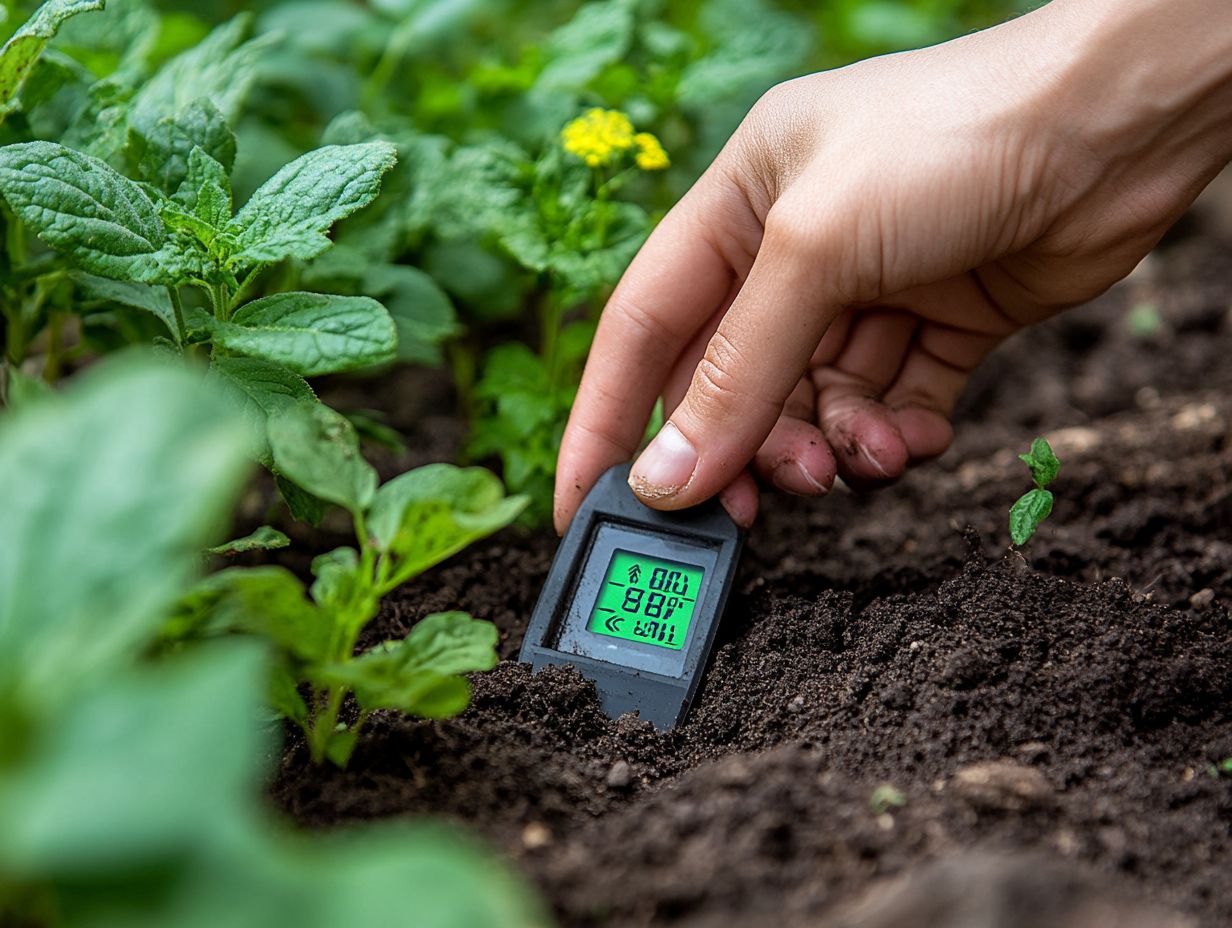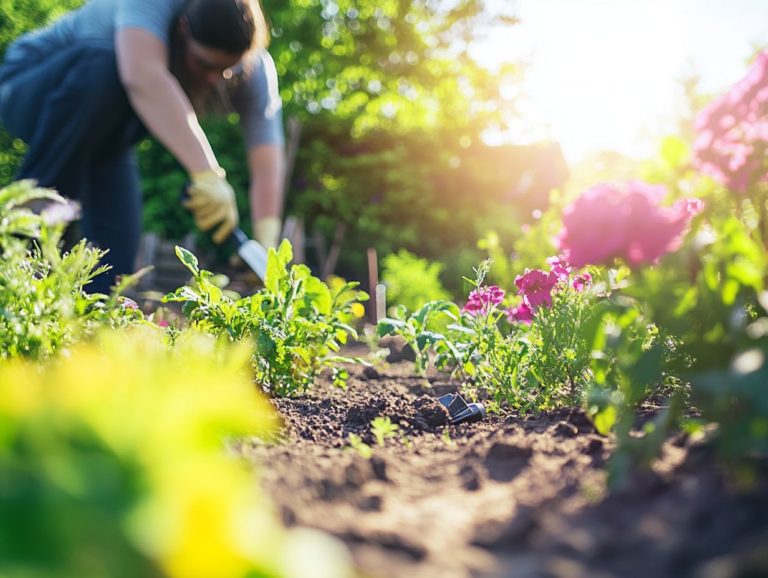How to Use Soil Moisture Meters Effectively
Soil moisture meters are invaluable tools for gardeners and farmers, ensuring that plants receive just the right amount of water for optimal growth.
This article delves into the essence of soil moisture meters and the myriad benefits they offer, from enhancing plant health to conserving precious water resources. You will find various types available, learn how to use them effectively, and gain insights into interpreting moisture readings accurately to enhance your gardening experience.
This guide offers essential tips for troubleshooting common issues, ensuring you achieve reliable results each time. Unlock the secrets of efficient watering practices and discover the essential gardening advice that can transform your plant care techniques!
Contents
- Key Takeaways:
- Understanding Soil Moisture Meters
- Benefits of Using Soil Moisture Meters
- Types of Soil Moisture Meters
- How to Use a Soil Moisture Meter
- Interpreting Moisture Readings
- Troubleshooting Common Issues
- Frequently Asked Questions
- What is a soil moisture meter, and why is it important for plant care and gardening?
- How do I use a soil moisture meter effectively?
- Do all soil moisture meters work the same way?
- Can a soil moisture meter be used for all types of soil?
- How often should I use a soil moisture meter?
- Are there any maintenance tips for keeping a soil moisture meter working effectively?
Key Takeaways:

- Understand the benefits of using soil moisture meters to improve plant health and conserve water.
- Differentiating between analog and digital meters helps you select the best option for your needs.
- Follow a step-by-step guide for using and interpreting moisture readings to adjust watering practices and troubleshoot any issues.
Understanding Soil Moisture Meters
Grasping the intricacies of soil moisture meters is vital for any devoted plant enthusiast, especially those cultivating indoor gardens and nurturing various plant types.
These handy tools measure soil moisture. They help you avoid overwatering and underwatering, keeping your plants happy!
By accurately measuring moisture content, a soil moisture meter can elevate your plant care routine, ensuring that your cherished plants like an African milk tree, a candelabra cactus, or your beloved pothos flourish in the best possible conditions.
What are Soil Moisture Meters?
Soil moisture meters are exceptional gardening tools designed to measure soil moisture content, typically by evaluating how easily electricity flows through the soil.
These devices come equipped with a probe, a stick-like tool that you can insert into the soil, enabling you to gauge the water levels in different soil types, which can vary significantly from one plant to another.
Using a soil moisture meter helps determine the optimal time to water, ensuring you provide just the right amount of hydration no more, no less.
Understanding moisture levels is essential for effective plant care since it directly impacts root health, growth rates, and overall plant vitality, especially in relation to varying soil conditions.
This knowledge enables you to customize your watering schedules according to the specific moisture needs of different plants, optimizing both environmental health and plant performance.
Benefits of Using Soil Moisture Meters
Utilizing soil moisture meters offers a wealth of benefits for both novice and experienced gardeners, making them indispensable tools for managing plant care.
By adopting these tools, you ensure optimal plant health through precise watering practices while promoting water conservation in your home gardening endeavors, creating a sustainable environment.
Improving Plant Health and Water Conservation
Watering plants correctly not only enhances the survival of your houseplants but also plays a key role in significant water conservation within your gardening endeavors, fostering a greater appreciation for plant care.
Knowing how to keep the right moisture levels is key to growing thriving plants, as it directly influences how roots grow, nutrient absorption, and the overall success of your gardening. By utilizing soil moisture meters, which are devices used to measure how wet or dry the soil is, you can closely monitor the hydration needs of your plants, ensuring that you water only when necessary. This tool gives you important information about the soil s moisture content, enabling you to create more precise and effective watering schedules.
Embracing these practices not only bolsters plant vitality but also champions sustainable gardening by minimizing water waste. Implementing these techniques leads to healthier plants and a reduced environmental footprint, allowing you to garden with both purpose and pride!
Types of Soil Moisture Meters

You ll find two main types of soil moisture meters on the market: analog and digital. Each serves specific gardening needs to suit your unique plant types. Each type boasts unique features tailored to various gardening preferences, allowing you to select the one that best fits your style.
Analog vs. Digital Meters
Analog soil moisture meters typically showcase a straightforward dial reading, while digital meters elevate the experience with precise moisture measurements, often incorporating features for deeper analysis of your plant metrics.
As you consider which type aligns best with your gardening aspirations, you might find yourself weighing the allure of simplicity against the desire for detailed insights into your plants’ watering frequency. Are you curious about which type of moisture meter suits your gardening style? For instance, if you’re an avid gardener tending to a diverse array of plants, digital meters could prove invaluable, allowing you to track moisture levels with greater accuracy.
On the other hand, if you lean towards a more direct approach, you may find yourself drawn to analog meters, enjoying the quick readings without the fuss of calibration or battery replacements perfect for casual gardening or gardening basics. Some appreciate the intuitive ease of a simple dial for everyday tasks, while others revel in the technological advantages that facilitate advanced monitoring for their more sensitive plant varieties.
How to Use a Soil Moisture Meter
Utilizing a soil moisture meter can truly elevate your approach to plant watering. By accurately checking your plants’ specific moisture requirements, you can foster an environment that promotes robust growth and vitality.
Step-by-Step Guide
To master the art of using a soil moisture meter, follow this step-by-step guide designed to help you perform a moisture test, enhance your plant care techniques, and address common plant care problems.
Start by picking a well-drained spot in your ceramic or terra-cotta pot where you ll assess moisture levels. Ensure proper soil drainage. Carefully insert the probe deep into the soil, steering clear of your plant’s roots especially with delicate varieties like pothos or succulents, as they don t take kindly to damage. Once the probe is settled, take a moment to let the reading stabilize.
After a brief pause, gently remove the probe and check the display for moisture levels, noting if the reading indicates dry soil or wet soil. Depending on whether you see a scale or a numerical reading, you can gauge whether your plant needs a drink. For example, if the meter indicates low moisture for your pothos, it s time to quench its thirst and adjust your watering rhythm accordingly. On the other hand, a succulent can typically go a bit longer without water, so wait until the reading suggests it’s truly dry before watering it.
Start using a soil moisture meter today for healthier plants!
Interpreting Moisture Readings
Interpreting moisture readings from your soil moisture meter is essential for crafting a watering schedule that aligns with the unique needs of your plants. By understanding these readings, you can ensure that your watering practices are both efficient and tailored to promote optimal growth.
These practices contribute significantly to your overall garden care.
Understanding Moisture Levels and Adjusting Watering Practices

Understanding moisture levels is crucial for refining your watering practices. This helps you avoid common pitfalls like overwatering and underwatering, which can jeopardize your plants’ health.
By assessing moisture levels, you can customize your approach and grow healthy plants. For example, succulents like ZZ plants thrive in soil that dries out completely between waterings. In contrast, Snake plants appreciate a bit more moisture but still flourish in well-draining soil, ideally allowing the top inch to dry out before watering again.
Using tools like moisture meters, humidity meters, or the classic finger test can elevate your watering routine. Each plant receives the tailored care it demands based on its unique preferences.
Troubleshooting Common Issues
Troubleshooting common issues with soil moisture meters can significantly enhance their effectiveness. This ensures you get accurate readings that are crucial for optimal plant care.
Addressing these concerns helps you nurture your plants with precision and confidence.
Tips for Accurate Readings and Maintenance
To ensure accurate readings from your soil moisture meter, regular maintenance and proper usage techniques are key for effective management of your plant health.
Cleaning the meter after each use is crucial, as soil particles can interfere with its readings. A gentle wipe with a damp cloth will suffice. Additionally, don’t forget to recalibrate the device periodically to maintain accuracy, especially as the growing season approaches.
Following the manufacturer’s guidelines for calibration is ideal, particularly before the growing season starts. Proper storage when the meter is not in use is equally important; keep it in a cool, dry place, away from direct sunlight, to protect the sensor from damage.
By adhering to these steps, you can enhance your irrigation practices, leading to healthier and more vibrant plants across your entire indoor garden.
Frequently Asked Questions
What is a soil moisture meter, and why is it important for plant care and gardening?
A soil moisture meter measures the amount of water in the soil. Knowing when and how much to water is crucial for your plants success!
How do I use a soil moisture meter effectively?

First, insert the probe into the soil at a depth of 4-6 inches. Wait a few seconds for the reading to stabilize, then take multiple readings in different areas of the garden to get an accurate average. Finally, refer to the guide provided with the meter to interpret the results and adjust watering accordingly.
Do all soil moisture meters work the same way?
No, different types of soil moisture meters, like probe meters, capacitance meters, and tensiometers, work differently. It’s important to understand the type you have and how to use it effectively.
Can a soil moisture meter be used for all types of soil?
Some soil moisture meters are designed specifically for certain soil types, such as sandy or clay soils. Check the specifications of your meter to ensure it’s suitable for the soil in your garden.
Start monitoring your soil today and watch your garden thrive!
How often should I use a soil moisture meter?
Use a soil moisture meter once or twice a week. Adjust this based on the weather and your plants needs.
During extreme heat or drought, check the moisture more often.
Are there any maintenance tips for keeping a soil moisture meter working effectively?
Clean the probe after each use. The probe is the device’s reading part that goes into the soil.
Store it in a dry place to ensure accurate readings. You should also calibrate the meter regularly according to the manufacturer’s instructions.






